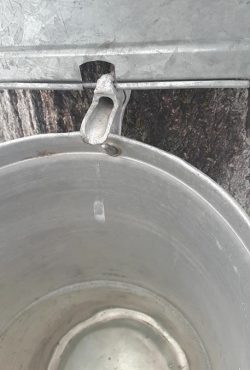Maple syrup season is just a few weeks away! In part one of this series we described how to prepare for the season and what equipment you’ll need, and in this post we describe how to tap your trees and boil the sap. Look out for the final post in a few weeks where we explain the finals stages of boiling and bottling maple syrup (and how to know when to stop!).
When to tap the trees: Sap flows when daytime and nighttime temperatures rise above and below 0’C. Ideal temperatures for sap flow are daytime temperatures of 6’C and nighttime temperatures of -5’C. Because it is based on weather, the maple syrup season can be different each year, and can last anywhere from 2 to 10 weeks. A good sign that the season is beginning is to look for sunken snow around the base of the trees (see video). Watch the weather forecast, and you can tap your trees a few days before you expect the sap to begin flowing.
How to tap the trees: Drill a hole at about waist height, 5-8 cms deep into the tree. Drill straight into the tree, no downward angle required. Gently hammer your tap into the tree until it feels firm and secure. Usually only 3-4 gentle taps are needed, and the tap should not go more than half-way into the hole. Hang a bucket from hook on the tap, or if using taps without hooks, place a bucket on the ground and run a piece of rubber hose from the tap and into the bucket.
Collecting the sap: Sap can be stored for 2-3 days if it is cold (or indefinitely if it is frozen), but it will spoil if left at room temperature for more than 24 hours. During a good day, you can collect 5-10 liters of sap per tap. On days where it is too cold, the sap will not run at all. This should help you plan ahead and decide when to boil.
Boiling the sap: When making small batches it is generally easier to boil the sap after each good run, until it has reduced in volume enough to store in a refrigerator or freezer, but not so much that it becomes maple syrup. Pour the sap into a large boiling pot and boil at maximum heat. Once about a third of the sap has evaporated off, top up with extra sap. Repeat this process until you run out of extra sap, then keep boiling until you have a manageable amount to store in your refrigerator. Be careful not to let the sap reduce so much that it burns – if the sap begins tasting syrupy and turning a golden colour, stop boiling. After the next run, you repeat the process by adding fresh sap to the original batch and continuing to boil. Then, at the end of the season (or after a few good runs), the now syrupy sap can be boiled down until it becomes maple syrup (more on that in the next post).
The sap was flowing well on this day in 2020! Note the ring of depressed snow around the base of the tree – an indicator that the season had begun.
Written by: Adam Gorgolewski


